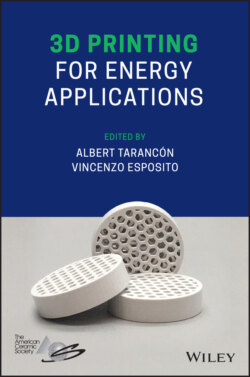Читать книгу 3D Printing for Energy Applications - Группа авторов - Страница 33
1.5.4 Debinding and Sintering
ОглавлениеThe debinding process serves to remove the matrix material of the green body part. Once removed, the component has reached an intermediate state, commonly known as the brown part. This, at large, is achieved by one of two methods. The most convenient is through a burn‐out cycle where the matrix material is debound by decomposing and outgassed from the green body part. This is in particular convenient as it can be integrated into a combined debind and sintering cycle in a programmable oven. This duration of this combined cycle is over multiple hours and in cases up to 2 days. For some specific feedstocks, a separate debinding method is added as an additional link in the process chain. This is introduced out of necessity, to ensure that the component integrity is maintained throughout the sintering cycle. This step involves a chemical dissolving of the binder by exposure to a solvent and is carried out as pertains to one or multiple of the following phenomena; Accumulation of residuals (e.g., soot) as a result of thermal debinding that can form impurities in the sintered component. Mitigation of crack formation during outgassing in case of thermal debinding. The possibility of infiltration of a functional component after debinding (a flux agent or introduction of a matrix component). Solvent‐based debinding is rarely applied at a large scale for industrial applications and is primarily seen applied when producing exotic components from novel materials.
